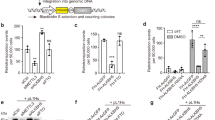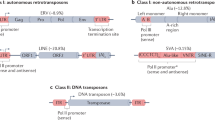Abstract
LINE-1 (L1) elements are the most abundant autonomous retrotransposons in the human genome, accounting for about 17% of human DNA. The L1 retrotransposon encodes two proteins, open reading frame (ORF)1 and the ORF2 endonuclease/reverse transcriptase. L1 RNA and ORF2 protein are difficult to detect in mammalian cells, even in the context of overexpression systems. Here we show that inserting L1 sequences on a transcript significantly decreases RNA expression and therefore protein expression. This decreased RNA concentration does not result from major effects on the transcription initiation rate or RNA stability. Rather, the poor L1 expression is primarily due to inadequate transcriptional elongation. Because L1 is an abundant and broadly distributed mobile element, the inhibition of transcriptional elongation by L1 might profoundly affect expression of endogenous human genes. We propose a model in which L1 affects gene expression genome-wide by acting as a ‘molecular rheostat’ of target genes. Bioinformatic data are consistent with the hypothesis that L1 can serve as an evolutionary fine-tuner of the human transcriptome.
This is a preview of subscription content, access via your institution
Access options
Subscribe to this journal
Receive 51 print issues and online access
$199.00 per year
only $3.90 per issue
Buy this article
- Purchase on Springer Link
- Instant access to full article PDF
Prices may be subject to local taxes which are calculated during checkout






Similar content being viewed by others
References
Lander, E. S. et al. Initial sequencing and analysis of the human genome. Nature 409, 860–921 (2001)
Swergold, G. D. Identification, characterization, and cell specificity of a human LINE-1 promoter. Mol. Cell. Biol. 10, 6718–6729 (1990)
Feng, Q., Moran, J. V., Kazazian, H. H. Jr & Boeke, J. D. Human L1 retrotransposon encodes a conserved endonuclease required for retrotransposition. Cell 87, 905–916 (1996)
Moran, J. V. et al. High frequency retrotransposition in cultured mammalian cells. Cell 87, 917–927 (1996)
Esnault, C., Maestre, J. & Heidmann, T. Human LINE retrotransposons generate processed pseudogenes. Nature Genet. 24, 363–367 (2000)
Wei, W. et al. Human L1 retrotransposition: cis preference versus trans complementation. Mol. Cell. Biol. 21, 1429–1439 (2001)
Kolosha, V. O. & Martin, S. L. In vitro properties of the first ORF protein from mouse LINE-1 support its role in ribonucleoprotein particle formation during retrotransposition. Proc. Natl Acad. Sci. USA 94, 10155–10160 (1997)
Martin, S. L. & Bushman, F. D. Nucleic acid chaperone activity of the ORF1 protein from the mouse LINE-1 retrotransposon. Mol. Cell. Biol. 21, 467–475 (2001)
Kolosha, V. O. & Martin, S. L. High-affinity, non-sequence-specific RNA binding by the open reading frame 1 (ORF1) protein from long interspersed nuclear element 1 (LINE-1). J. Biol. Chem. 278, 8112–8117 (2003)
Dewannieux, M., Esnault, C. & Heidmann, T. LINE-mediated retrotransposition of marked Alu sequences. Nature Genet. 35, 41–48 (2003)
Luan, D. D., Korman, M. H., Jakubczak, J. L. & Eickbush, T. H. Reverse transcription of R2Bm RNA is primed by a nick at the chromosomal target site: a mechanism for non-LTR retrotransposition. Cell 72, 595–605 (1993)
Cost, G. J., Feng, Q., Jacquier, A. & Boeke, J. D. Human L1 element target-primed reverse transcription in vitro. EMBO J. 21, 5899–5910 (2002)
Boissinot, S., Entezam, A. & Furano, A. V. Selection against deleterious LINE-1-containing loci in the human lineage. Mol. Biol. Evol. 18, 926–935 (2001)
Szak, S. T. et al. Molecular archeology of L1 insertions in the human genome. Genome Biol 3, research00521–researc005218 (2002)
Mathias, S. L., Scott, A. F., Kazazian, H. H. Jr, Boeke, J. D. & Gabriel, A. Reverse transcriptase encoded by a human transposable element. Science 254, 1808–1810 (1991)
Clements, A. P. & Singer, M. F. The human LINE-1 reverse transcriptase: effect of deletions outside the common reverse transcriptase domain. Nucleic Acids Res. 26, 528–3535 (31998)
Branciforte, D. & Martin, S. L. Developmental and cell type specificity of LINE-1 expression in mouse testis: implications for transposition. Mol. Cell. Biol. 14, 2584–2592 (1994)
Trelogan, S. A. & Martin, S. L. Tightly regulated, developmentally specific expression of the first open reading frame from LINE-1 during mouse embryogenesis. Proc. Natl Acad. Sci. USA 92, 1520–1524 (1995)
Perepelitsa-Belancio, V. & Deininger, P. RNA truncation by premature polyadenylation attenuates human mobile element activity. Nature Genet. 35, 363–366 (2003)
Boissinot, S., Chevret, P. & Furano, A. V. L1 (LINE-1) retrotransposon evolution and amplification in recent human history. Mol. Biol. Evol. 17, 915–928 (2000)
Gilbert, N., Lutz-Prigge, S. & Moran, J. V. Genomic deletions created upon LINE-1 retrotransposition. Cell 110, 315–325 (2002)
Symer, D. E. et al. Human L1 retrotransposition is associated with genetic instability in vivo. Cell 110, 327–338 (2002)
Feng, Q. Mechanism of Human L1 Element Retrotransposition. Thesis, Johns Hopkins Univ. (1996)
Chávez, S. et al. Hpr1 is preferentially required for transcription of either long or G + C-rich DNA sequences in Saccharomyces cerevisiae. Mol. Cell. Biol. 21, 7054–7064 (2001)
Han, J. S. & Boeke, J. D. A highly active synthetic mammalian retrotransposon. Nature 429, 314–318 (2004)
Cost, G. J. & Boeke, J. D. Targeting of human retrotransposon integration is directed by the specificity of the L1 endonuclease for regions of unusual DNA structure. Biochemistry 37, 18081–18093 (1998)
Minakami, R. et al. Identification of a cis-element essential for the human L1 transcription and a nuclear factor(s) binding to the element. Nucleic Acids Res. 20, 3139–3145 (1992)
Tchenio, T., Casella, J. F. & Heidmann, T. Members of the SRY family regulate the human LINE-1 retrotransposons. Nucleic Acids Res. 28, 411–415 (2000)
Yang, N., Zhang, L., Zhang, Y. & Kazazian, H. H. Jr An important role for RUNX3 in human L1 transcription and retrotransposition. Nucleic Acids Res. 31, 4929–4940 (2003)
Xu, Q., Nakanishi, T., Sekimizu, K. & Natori, S. Cloning and identification of testis-specific transcription elongation factor S-II. J. Biol. Chem. 269, 3100–3103 (1994)
Miller, T., Williams, K., Johnstone, R. W. & Shilatifard, A. Identification, cloning, expression, and biochemical characterization of the testis-specific RNA polymerase II elongation factor ELL3. J. Biol. Chem. 275, 32052–32056 (2000)
Schwahn, U. et al. Positional cloning of the gene for X-linked retinitis pigmentosa 2. Nature Genet. 19, 327–332 (1998)
Yajima, I. et al. An L1 element intronic insertion in the black-eyed white (Mitf[mi-bw]) gene: the loss of a single Mitf isoform responsible for the pigmentary defect and inner ear deafness. Hum. Mol. Genet. 8, 1431–1441 (1999)
Hickey, D. A. Selfish DNA: a sexually-transmitted nuclear parasite. Genetics 101, 519–531 (1982)
Bestor, T. H. Sex brings transposons and genomes into conflict. Genetica 107, 289–295 (1999)
Levis, R. W., Ganesan, R., Houtchens, K., Tolar, L. A. & Sheen, F. M. Transposons in place of telomeric repeats at a Drosophila telomere. Cell 75, 1083–1093 (1993)
Agrawal, A., Eastman, Q. M. & Schatz, D. G. Transposition mediated by RAG1 and RAG2 and its implications for the evolution of the immune system. Nature 394, 744–751 (1998)
Tang, W. et al. Secreted and membrane attractin result from alternative splicing of the human ATRN gene. Proc. Natl Acad. Sci. USA 97, 6025–6030 (2000)
Zarudnaya, M. I., Kolomiets, I. M., Potyahaylo, A. L. & Hovorun, D. M. Downstream elements of mammalian pre-mRNA polyadenylation signals: primary, secondary and higher-order structures. Nucleic Acids Res. 31, 1375–1386 (2003)
Burwinkel, B. & Kilimann, M. W. Unequal homologous recombination between LINE-1 elements as a mutational mechanism in human genetic disease. J. Mol. Biol. 277, 513–517 (1998)
Moran, J. V., DeBerardinis, R. J. & Kazazian, H. H. Jr Exon shuffling by L1 retrotransposition. Science 283, 1530–1534 (1999)
Goodier, J. L., Ostertag, E. M. & Kazazian, H. H. Jr Transduction of 3′-flanking sequences is common in L1 retrotransposition. Hum. Mol. Genet. 9, 653–657 (2000)
Pickeral, O. K., Makalowski, W., Boguski, M. S. & Boeke, J. D. Frequent human genomic DNA transduction driven by LINE-1 retrotransposition. Genome Res. 10, 411–415 (2000)
Okazaki, Y. et al. Analysis of the mouse transcriptome based on functional annotation of 60,770 full-length cDNAs. Nature 420, 563–573 (2002)
Yan, H., Yuan, W., Velculescu, V. E., Vogelstein, B. & Kinzler, K. W. Allelic variation in human gene expression. Science 297, 1143 (2002)
Lo, H. S. et al. Allelic variation in gene expression is common in the human genome. Genome Res. 13, 1855–1862 (2003)
Cuello, P., Boyd, D. C., Dye, M. J., Proudfoot, N. J. & Murphy, S. Transcription of the human U2 snRNA genes continues beyond the 3′ box in vivo. EMBO J. 18, 2867–2877 (1999)
Dieckmann, T., Butcher, S. E., Sassanfar, M., Szostak, J. W. & Feigon, J. Mutant ATP-binding RNA aptamers reveal the structural basis for ligand binding. J. Mol. Biol. 273, 467–478 (1997)
Sassanfar, M. & Szostak, J. W. An RNA motif that binds ATP. Nature 364, 550–553 (1993)
Oliver, J. L. et al. Isochore chromosome maps of the human genome. Gene 300, 117–127 (2002)
Acknowledgements
We thank Y. Aizawa, J. Corden, J. Moran, J. Nathans, S.-L. Ooi and D. Valle for helpful discussions and critical reading of the manuscript, S. Wheelan for unpublished bioinformatics data, S. Murphy for providing a detailed nuclear run-on protocol, J. Moran for pY104, H. Kazazian for pTN201, and R. Bandaru for help with statistical analysis. This work was supported by the NIH (J.D.B.) and the Medical Scientist Training Program (J.S.H.).
Author information
Authors and Affiliations
Corresponding author
Ethics declarations
Competing interests
The authors declare that they have no competing financial interests.
Supplementary information
Supplementary Table S1
The sequence of oligonucleotides used. (PDF 93 kb)
Supplementary Figures S1 to S4
Supplementary Figure S1: The structure of the test expression reporter used is depicted for each lane of each figure in this manuscript; Supplementary Figure S2: Northern blot analysis of total RNA in different cells; Supplementary Figure S3: Protein levels in ORF2 deletion constructs; Supplementary Figure S4: Comparison of GFPlacZ and GFPORF2 RNA half-life by real time RT-PCT. (PDF 2444 kb)
Rights and permissions
About this article
Cite this article
Han, J., Szak, S. & Boeke, J. Transcriptional disruption by the L1 retrotransposon and implications for mammalian transcriptomes. Nature 429, 268–274 (2004). https://doi.org/10.1038/nature02536
Received:
Accepted:
Issue Date:
DOI: https://doi.org/10.1038/nature02536
Comments
By submitting a comment you agree to abide by our Terms and Community Guidelines. If you find something abusive or that does not comply with our terms or guidelines please flag it as inappropriate.



